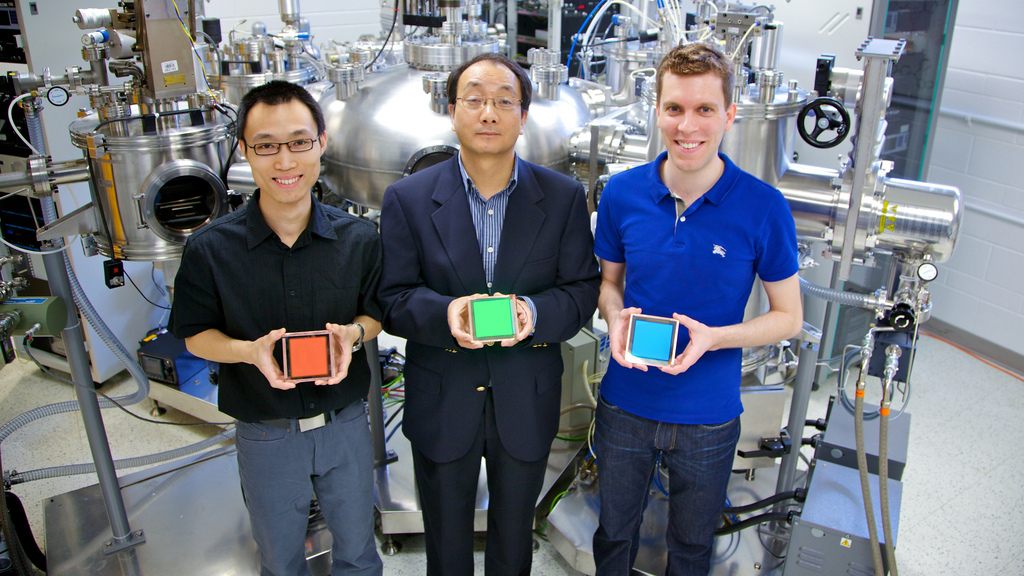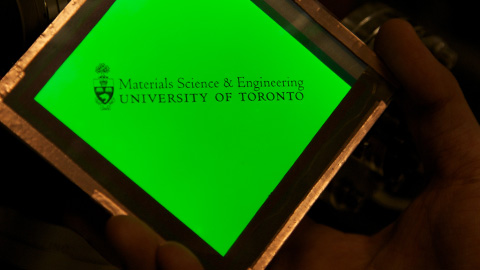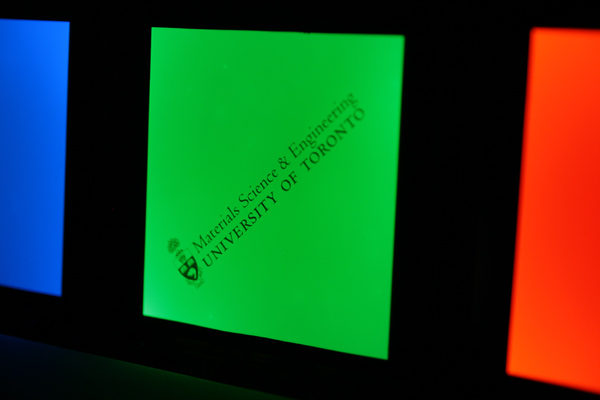One-atom thick chlorine reduces OLED device complexity while enabling record efficiencies

Photo (from left): doctoral candidate Zhibin Wang, Professor Zheng-Hong Lu, Canada Research Chair in Organic Optoelectronics, and doctoral candidate Michael Helander showcase their record-breaking Cl-OLEDs
April 14, 2011
Chlorine: an abundant and readily available halogen gas commonly associated with the sanitation of swimming pools and drinking water – could a one-atom thick sheet of this element revolutionize the next generation of flat-panel displays and lighting technology?
In the case of Organic Light-Emitting Diode (OLED) devices, it most certainly can. U of T materials science and engineering doctoral researchers Michael G. Helander and Zhibin Wang, led by Professor Zheng-Hong Lu, Canada Research Chair in Organic Optoelectronics have found a simple method of using chlorine to drastically reduce traditional OLED device complexity and dramatically improve its efficiency all at the same time. By engineering a one-atom thick sheet of chlorine onto the surface of an existing industry-standard electrode material (indium tin oxide, ITO) found in today’s flat-panel displays, these researchers have created a medium that allows for efficient electrical transport while eliminating the need for several costly layers found in traditional OLED devices.
By engineering a one-atom thick sheet of chlorine onto the surface of an existing industry-standard electrode material (indium tin oxide, ITO) found in today’s flat-panel displays, these researchers have created a medium that allows for efficient electrical transport while eliminating the need for several costly layers found in traditional OLED devices.

“It turns out that it’s remarkably easy to engineer this one-atom thick layer of chlorine onto the surface of ITO,” says Helander. “We developed a UV light assisted process to achieve chlorination, which negates the need for chlorine gas, making the entire procedure safe and reliable.”
The team tested their green-emitting “Cl-OLED” against a conventional OLED and found that th e efficiency was more than doubled at very high brightness. “OLEDs are known for their high-efficiency,” describes Helander. “However, the challenge in conventional OLEDs is that as you increase the brightness, the efficiency drops off rapidly.” Using their chlorinated ITO, this team of advanced materials researchers found that they were able to prevent this drop off and achieve a record efficiency of 50% at 10,000 cd/m2 (a standard florescent light has a brightness of approximately 8,000 cd/m2), which is at least two times more efficient than the conventional OLED.
The team tested their green-emitting “Cl-OLED” against a conventional OLED and found that the efficiency was more than doubled at very high brightness.

“Our Cl-ITO eliminates the need for several stacked layers found in traditional OLEDs, reducing the number of manufacturing steps and equipment, which ultimately cuts down on the costs associated with setting up a production line,” said Professor Lu. “This effectively lowers barriers for mass production and thereby accelerates the adoption of OLED devices into mainstream flat-panel displays and other lighting technologies.”
The results of this work titled “Chlorinated Indium Tin Oxide Electrodes with High Work Function for Organic Device Compatibility” are published online in the journal, Science, on April 14, 2011 (Science DOI: 10.1126/science.1202992).
Helander, Wang and Lu’s OLED breakthrough have been subsequently featured by Engadget, Ubergizmo, The Engineer and Printed Electronics World.
Contact
Luke Y. H. Ng, External Relations & Student Life Officer
Department of Materials Science & Engineering, University of Toronto
T: 416.946.3211 | E: mse.external@utoronto.ca